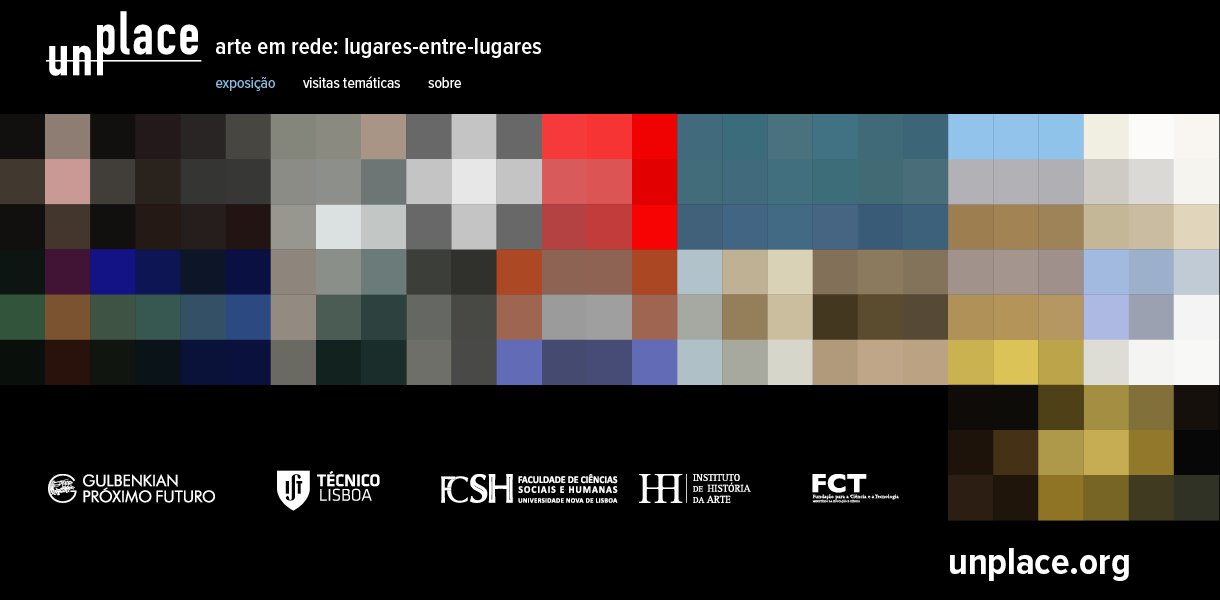unplace: presentation of the Ebooks and of the online exhibition
Presentation of the ebooks Uncertain Spaces: Virtual Configurations in Contemporary Art and Museums (edited by Helena Barranha and Susana S. Martins) and Museus sem lugar: ensaios, manifestos e diálogos em rede (edited by Helena Barranha, Susana S. Martins and António Pinto Ribeiro).
Followed by the launch of the online exhibition unplace, networked art: places-between-places (Curated by: António Pinto Ribeiro and Rita Xavier Monteiro).
unplace – A Museum Without a Place: Intangible Museography and Virtual Exhibitions is a scientific and artistic project that explores the possibilities and limitations of technology and digital expression, particularly within the internet, in the form of theoretical experiments and a visual art exhibition titled unplace, networked art: places-between-places. unplace is a project jointly coordinated by the Calouste Gulbenkian Foundation (the Gulbenkian Next Future Programme), the Instituto Superior Técnico – Universidade de Lisboa (through IST-ID and ICIST) and the Universidade Nova de Lisboa (Instituto de História da Arte). It is also funded by the Fundação para a Ciência e a Tecnologia (state budget ref: EXPL/CPC-EAT/1175/2013).

© GBNT
During the research period for this exhibition, which began in March 2014, we took part in various seminars and symposia that addressed this issue, and organised an international conference (at the Calouste Gulbenkian Foundation, 31 October – 1 November 2014). A number of papers from this conference will be presented in one of the ebooks.
We also launched an open call for artistic projects, whose three winners are included in this virtual exhibition: Hanna Husberg and Laura McLean – Contingent Movements Archive; John F Barber - Radio Nouspace; and LiMac [Sandra Gamarra Heshiki and Antoine Henry Jonquères] - Solo Show.
Being so, the exhibition includes works from the following artists: Ahmed El Saher (Egypt), Ai Weiwei (China), Olafur Eliasson (Denmark/Germany), Alfredo Jaar (Chile/USA), Art is Open Source (Italy), Clement Valla (France/USA), Giselle Beiguelman (Brazil), MIIAC-João Paulo Serafim (Portugal), JODI (Belgium/Holland), John Barber (EUA), Paula Levine (Canada/USA), Thomson & Craighead (United Kingdom), Wilfredo Prieto (Cuba), Perry Bard (Canada), LiMaC - Sandra Gamarra (Peru/Spain) and Antoine-Henry Jonquères (France/Spain), Hanna Husberg (Finland/Sweden) and Laura McLean (Australia/United Kingdom), S.A.R.L. group (Portugal).
The unplace exhibition that marks the culmination this project is the result of these months of research, investigation, experiments and information gathering, with the additional input of the curatorial perspective of António Pinto Ribeiro and Rita Xavier Monteiro, which underpinned the criteria, the choices made and informed the design of this website.
Now relatively deterritorialised, what is particular about the works in this exhibition is that their reception is determined purely by our visual, auditory and kinaesthetic senses – the senses of touch and smell commonly employed in material and performative works are completely excluded. These works are constantly moving, and this is one of the great open questions posed by this ‘artistic genre’. They may appear amidst the flow of other images, data, diagrams or email. They may be saved or pass through filters, subject to coded protocols of accessibility, and they may be accessible in visual infrastructures or connected to other real infrastructures. This polyvalence places the works in a constant state of flux, which is part of their fascination and relevance.
In the choices we made here, we were mindful of how easy it is to be seduced by virtual technology, served by sophisticated software and satellites – technology’s spectacularity, in other words – and focused on the artistic effect, on the new type of impact that this genre can produce. We were particularly pleased to come across works in which there was underlying, or indeed explicit, critical thought, and an activist approach to the control of the mechanisms of production, storage and dissemination or censorship of digital information within the international systems in operation.
The unplace project was carried out, over around a year and a half, by a team that brought together contributors from the three institutions. As well as the core team of researchers – Helena Barranha (IR), António Pinto Ribeiro and Susana Martins – significant contributions were made by Alexandra Bounia, Raquel Pereira and Rita Xavier Monteiro, while the temporary participation of Felisa Perez and Catarina Rebelo Guerra was fundamental. Production and management also played a decisive part in making the project possible, with notable work by Lúcia Marques, Vítor Alves Brotas, Rosa Paula Matos and Eduardo Inês. Website design is by WeAreBoq and the exhibition layout and implementation is by GBNT.
